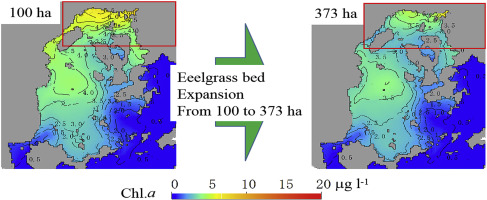当前位置:
X-MOL 学术
›
J. Environ. Manag.
›
论文详情
Our official English website, www.x-mol.net, welcomes your
feedback! (Note: you will need to create a separate account there.)
Impact of eelgrass bed recovery and expansion on phytoplankton growth through nutrient competition.
Journal of Environmental Management ( IF 8.0 ) Pub Date : 2020-01-11 , DOI: 10.1016/j.jenvman.2019.109898 Feng Wang 1 , Wataru Nishijima 2 , Yota Uchida 1 , Akira Umehara 2 , Satoshi Nakai 1 , Kenki Kasamo 3 , Yoshiaki Shiraki 3
Journal of Environmental Management ( IF 8.0 ) Pub Date : 2020-01-11 , DOI: 10.1016/j.jenvman.2019.109898 Feng Wang 1 , Wataru Nishijima 2 , Yota Uchida 1 , Akira Umehara 2 , Satoshi Nakai 1 , Kenki Kasamo 3 , Yoshiaki Shiraki 3
Affiliation

|
Eelgrass beds are highly productive and support diverse faunal assemblages; they also take in nutrients from the water and prevent excessive phytoplankton growth in eutrophic coastal waters through the reduction of available nutrients. Despite its importance, the global distribution of eelgrass has declined worldwide. In eutrophic areas with high chlorophyll a (Chl.a) concentrations, natural recovery of eelgrass beds after eutrophication is possible. To facilitate this, sufficient water clarity can be reached after a large enough decrease in phytoplankton concentration. In this study, we proposed a novel indicator for the maximum possible Secchi depth (MPSD), defined as the Secchi depth when the Chl.a concentration is equal to a reference Chl.a concentration. We applied the MPSD to evaluate water clarity improvements through the reduction of terrigenous anthropogenic nutrient loading. We found that phytoplankton did not control water clarity in the study area, which was instead controlled by background factors. Therefore, improvements in water clarity would not be expected after reducing terrigenous anthropogenic nutrient loading. The habitat of Zostera marina is determined by light availability, so we investigated a potential area with ≥20% surface irradiance and Z. marina existed in 27% of it (100 of 373 ha). The maximum further recovery of eelgrass by Secchi depth improvements to the MPSD was estimated at 36 ha. The impact of eelgrass recovery and expansion on phytoplankton growth from May to September was evaluated by a mathematical model under two scenarios: the current eelgrass distribution (100 ha) and potential maximum eelgrass distribution (373 ha). A Chl.a decrease of 1.0-3.0 μg l-1 from 4.0 to 7.0 μg l-1 was achieved in an area from May to July, and the improvement decreased with time. These evaluation methods and findings could help us gain a better understanding of the nutrient management in seagrass-vegetated semi-enclosed seas subjected to anthropogenic nutrient input.
中文翻译:

鳗草床层恢复和扩张对养分竞争对浮游植物生长的影响。
鳗草床的生产力很高,可以支持多种动物群落。它们还从水中吸收养分,并通过减少可用养分来防止富营养化沿海水域中浮游植物的过度生长。尽管很重要,但鳗草的全球分布在世界范围内有所下降。在高叶绿素a(Chl.a)浓度的富营养化地区,富营养化后鳗草床的自然恢复是可能的。为了促进这一点,在浮游植物浓度大大降低之后,可以达到足够的水透明度。在这项研究中,我们提出了一种新的指标,用于最大可能的塞基深度(MPSD),定义为当Cha.a浓度等于参考Chl.a浓度时的塞基深度。我们应用MPSD来评估通过减少陆源性人为营养物负荷来改善水的清晰度。我们发现浮游植物不控制研究区域内的水质澄清度,而是由背景因素控制。因此,减少陆源性人为营养物的负荷后,水的澄清度不会提高。Zostera滨海地区的生境取决于光的可用性,因此我们调查了表面辐照度≥20%的潜在区域,其中Z. marina滨海地区存在27%(373公顷中的100处)。通过对MPSD进行Secchi深度改进,可以最大程度地恢复鳗gra草的面积为36公顷。在以下两种情况下,通过数学模型评估了鳗草的恢复和扩张对5月至9月浮游植物生长的影响:当前的鳗草分布(100公顷)和潜在的最大鳗草分布(373公顷)。在5月至7月的某个区域中,Chla.a从4.0-7.0μgl-1降低了1.0-3.0μgl-1,并且随着时间的推移,改善程度有所降低。这些评估方法和发现可以帮助我们更好地了解人工输入养分的海草植被半封闭海域的养分管理。
更新日期:2020-01-13
中文翻译:

鳗草床层恢复和扩张对养分竞争对浮游植物生长的影响。
鳗草床的生产力很高,可以支持多种动物群落。它们还从水中吸收养分,并通过减少可用养分来防止富营养化沿海水域中浮游植物的过度生长。尽管很重要,但鳗草的全球分布在世界范围内有所下降。在高叶绿素a(Chl.a)浓度的富营养化地区,富营养化后鳗草床的自然恢复是可能的。为了促进这一点,在浮游植物浓度大大降低之后,可以达到足够的水透明度。在这项研究中,我们提出了一种新的指标,用于最大可能的塞基深度(MPSD),定义为当Cha.a浓度等于参考Chl.a浓度时的塞基深度。我们应用MPSD来评估通过减少陆源性人为营养物负荷来改善水的清晰度。我们发现浮游植物不控制研究区域内的水质澄清度,而是由背景因素控制。因此,减少陆源性人为营养物的负荷后,水的澄清度不会提高。Zostera滨海地区的生境取决于光的可用性,因此我们调查了表面辐照度≥20%的潜在区域,其中Z. marina滨海地区存在27%(373公顷中的100处)。通过对MPSD进行Secchi深度改进,可以最大程度地恢复鳗gra草的面积为36公顷。在以下两种情况下,通过数学模型评估了鳗草的恢复和扩张对5月至9月浮游植物生长的影响:当前的鳗草分布(100公顷)和潜在的最大鳗草分布(373公顷)。在5月至7月的某个区域中,Chla.a从4.0-7.0μgl-1降低了1.0-3.0μgl-1,并且随着时间的推移,改善程度有所降低。这些评估方法和发现可以帮助我们更好地了解人工输入养分的海草植被半封闭海域的养分管理。











































 京公网安备 11010802027423号
京公网安备 11010802027423号